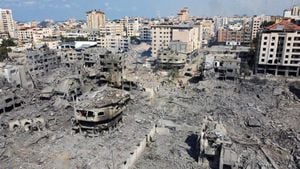Across the Philippines, the clouds have gathered ominously as Tropical Depression Igme churned through the skies, bringing with it heavy monsoon rains. This situation has been particularly problematic, leading to flooding and prompting the government to respond swiftly to safeguard communities vulnerable to the relentless downpour.
The Philippine Atmospheric, Geophysical and Astronomical Services Administration (PAGASA) confirmed the tropical depression's formation, which came as no surprise to many meteorologists who had been observing the weather patterns leading up to this event. They had warned citizens about possible impacts from this storm. "The public is advised to take necessary precautions due to the potential for hazardous conditions," authorities stressed. PAGASA indicated the threat level was heightened as the rain intensified.
Based on the latest weather updates, the depression was spotted approximately 265 kilometers east of Infanta, Quezon. The storm was moving west-northwest at around 20 kilometers per hour. With wind speeds reaching 45 kilometers per hour, there were fears it would strengthen, prompting alerts for coastal areas, which would bear the brunt of both wind and heavy rains.
Local governments had already set emergency operations centers on high alert, ready to deploy rescue teams and resources to areas likely to experience flash flooding or landslides. Residents were encouraged to stay indoors, especially those living near rivers and low-lying areas.
Reports from various provinces indicate widespread effects. The National Disaster Risk Reduction and Management Council (NDRRMC) reported crop damage and infrastructure disruption across several regions. Farmers were particularly worried—many had just begun to see their crops come to fruition before being battered by this severe weather.
Heartbreaking images surfaced on social media, showing flooded streets, submerged homes, and communities banding together to save neighbors from the rising waters. Livelihoods were at stake as local businesses prepared for the worst, reinforcing their premises with sandbags and barricades. Many citizens expressed their anxiety about the storm. "We just got out of another disaster, and here we are facing another one. It feels overwhelming," lamented Miriam, a resident of Manila.
PAGASA also warned about the extension of the southwest monsoon, which had already been causing erratic weather. This phenomenon, commonly known as the "habagat," can lead to torrential rains across the archipelago, paving the way for more unstable weather patterns, thanks to the influence of other nearby weather systems.
The monsoon season is nothing new for the people living across the Philippine archipelago. Each year, August brings sweltering humidity along with downpours, but the intensity of storms seems to be increasing. This year alone had seen multiple disturbances, with several tropical depressions gradually morphing from mere weather events to cataclysmic forces.
On the ground, local community leaders organized relief efforts as soon as the rains intensified. They prepared emergency packages consisting of food, water, and hygiene items to distribute to families affected by flooding. The real heroes of these storms are often the volunteers—individuals ready to lend their time and energy to help those hit hardest.
The Philippine Red Cross, among other organizations, mobilized teams and aid. Their efforts included providing temporary shelters for those forced from their homes and medical assistance for those affected by flash flooding. Their representative stated, "We are preparing for something bigger than we anticipated. Our volunteers are going above and beyond to meet the needs of our people during this tough time."
Transportation was also significantly affected, with numerous ferry services suspended and flights grounded, echoing the warnings from PAGASA about the adverse impact on travel. AirAsia and other airlines announced flight cancellations, forcing travelers to scramble for alternative options.
Despite the chaos, the resilience of Filipinos shined through. Many shared their stories of survival and unity during turbulent times, with strangers opening their doors to those displaced. Social media buzzed with hashtags encouraging support and solidarity, highlighting the strength of community spirit.
Officials maintained regular updates on the weather situation, persistently advising residents to stay vigilant and follow any evacuation orders or guidelines issued by local authorities. Education and health facilities also remained closed, ensuring safety for students and staff during this hazardous period.
Though the storm's fury raged outside, within neighborhoods, voices of hope emerged. Where disaster struck, aid was organized swiftly, and numerous citizens rallied for each other, embodying the idea of bayanihan—community spirit deeply ingrained within Filipino culture.
Looking forward, the situation remains fluid. Meteorologists continue to monitor Tropical Depression Igme, but many are eager for this turbulent weather to pass. Communities, though battered, stand ready to rebuild, facing each storm with courage and determination.
While the immediate threat from Igme is still at the forefront of many minds, the long-term ramifications of climate change linger, pushing many to ask: How can communities like these bolster their defenses and preparedness for storms to come? It's clear from this experience and the many had before, investing in infrastructure, early warning systems, and effective response mechanisms are key to minimizing future hardships.



